1. Vakil N. Disease definition, clinical manifestations, epidemiology and natural history of GERD. Best Pract Res Clin Gastroenterol. 2010; 24(6):759–764. PMID:
21126691.

2. Gaude GS. Pulmonary manifestations of gastroesophageal reflux disease. Ann Thorac Med. 2009; 4(3):115–123. PMID:
19641641.

3. Field SK. A critical review of the studies of the effects of simulated or real gastroesophageal reflux on pulmonary function in asthmatic adults. Chest. 1999; 115(3):848–856. PMID:
10084501.


4. Iliaz S, Iliaz R, Onur ST, Arici S, Akyuz U, Karaca C, et al. Does gastroesophageal reflux increase chronic obstructive pulmonary disease exacerbations? Respir Med. 2016; 115:20–25. PMID:
27215499.


5. Vakil N, van Zanten SV, Kahrilas P, Dent J, Jones R. Global Consensus Group. The Montreal definition and classification of gastroesophageal reflux disease: a global evidence-based consensus. Am J Gastroenterol. 2006; 101(8):1900–1920. PMID:
16928254.


6. Nemzek JA, Kim J. Pulmonary inflammation and airway hyperresponsiveness in a mouse model of asthma complicated by acid aspiration. Comp Med. 2009; 59(4):321–330. PMID:
19712571.


7. Ravelli AM, Panarotto MB, Verdoni L, Consolati V, Bolognini S. Pulmonary aspiration shown by scintigraphy in gastroesophageal reflux-related respiratory disease. Chest. 2006; 130(5):1520–1526. PMID:
17099032.


8. Araujo AC, Aprile LR, Dantas RO, Terra-Filho J, Vianna EO. Bronchial responsiveness during esophageal acid infusion. Lung. 2008; 186(2):123–128. PMID:
18297339.


9. Lozo Vukovac E, Lozo M, Mise K, Gudelj I, Puljiz Ž, Jurcev-Savicevic A, et al. Bronchoalveolar pH and inflammatory biomarkers in newly diagnosed IPF and GERD patients: a case-control study. Med Sci Monit. 2014; 20:255–261. PMID:
24535066.



10. Wright RA, Miller SA, Corsello BF. Acid-induced esophagobronchial-cardiac reflexes in humans. Gastroenterology. 1990; 99(1):71–73. PMID:
2344943.


11. Savarino E, Carbone R, Marabotto E, Furnari M, Sconfienza L, Ghio M, et al. Gastro-oesophageal reflux and gastric aspiration in idiopathic pulmonary fibrosis patients. Eur Respir J. 2013; 42(5):1322–1331. PMID:
23471347.


12. Morehead RS. Gastro-oesophageal reflux disease and non-asthma lung disease. Eur Respir Rev. 2009; 18(114):233–243. PMID:
20956148.

13. Kiljander TO, Laitinen JO. The prevalence of gastroesophageal reflux disease in adult asthmatics. Chest. 2004; 126(5):1490–1494. PMID:
15539717.

14. Benson VS, Müllerová H, Vestbo J, Wedzicha JA, Patel A, Hurst JR, et al. Associations between gastro-oesophageal reflux, its management and exacerbations of chronic obstructive pulmonary disease. Respir Med. 2015; 109(9):1147–1154. PMID:
26166017.


15. Hu ZW, Wang ZG, Zhang Y, Wu JM, Liu JJ, Lu FF, et al. Gastroesophageal reflux in bronchiectasis and the effect of anti-reflux treatment. BMC Pulm Med. 2013; 13(1):34. PMID:
23731838.



16. Kim SW, Lee JH, Sim YS, Ryu YJ, Chang JH. Prevalence and risk factors for reflux esophagitis in patients with chronic obstructive pulmonary disease. Korean J Intern Med. 2014; 29(4):466–473. PMID:
25045294.



17. Lee AL, Goldstein RS. Gastroesophageal reflux disease in COPD: links and risks. Int J Chron Obstruct Pulmon Dis. 2015; 10:1935–1949. PMID:
26392769.



18. Mandal P, Morice AH, Chalmers JD, Hill AT. Symptoms of airway reflux predict exacerbations and quality of life in bronchiectasis. Respir Med. 2013; 107(7):1008–1013. PMID:
23683772.


19. Houghton LA, Lee AS, Badri H, DeVault KR, Smith JA. Respiratory disease and the oesophagus: reflux, reflexes and microaspiration. Nat Rev Gastroenterol Hepatol. 2016; 13(8):445–460. PMID:
27381074.


20. Sharifi A, Ansarin K. Effect of gastroesophageal reflux disease on disease severity and characteristics of lung functional changes in patients with asthma. J Cardiovasc Thorac Res. 2014; 6(4):223–228. PMID:
25610553.



21. Lee HB, Lee YD, Kim HC, Lee YC, Lee ST, Rhee YK. Relationship between exercise induced asthma and gastroesophageal reflux. Tuberc Respir Dis. 2000; 48(2):203–209.

22. Lundell LR, Dent J, Bennett JR, Blum AL, Armstrong D, Galmiche JP, et al. Endoscopic assessment of oesophagitis: clinical and functional correlates and further validation of the Los Angeles classification. Gut. 1999; 45(2):172–180. PMID:
10403727.



23. Dent J. Endoscopic grading of reflux oesophagitis: the past, present and future. Best Pract Res Clin Gastroenterol. 2008; 22(4):585–599. PMID:
18656818.


24. Choi J, Paek D, Lee J. Normal predictive values of spirometry in Korean population. Tuberc Respir Dis. 2005; 58(3):230–242.

25. Miller MR, Crapo R, Hankinson J, Brusasco V, Burgos F, Casaburi R, et al. General considerations for lung function testing. Eur Respir J. 2005; 26(1):153–161. PMID:
15994402.

26. Pellegrino R, Viegi G, Brusasco V, Crapo RO, Burgos F, Casaburi R, et al. Interpretative strategies for lung function tests. Eur Respir J. 2005; 26(5):948–968. PMID:
16264058.

27. Ali E, Abdelhamid H, Shalaby H. Effect of gastroesophageal reflux disease on spirometry, lung diffusion, and impulse oscillometry. Egypt J Bronchol. 2016; 10(2):189–196.

28. Baldomero AK, Wendt CH, Petersen A, Gaeckle NT, Han MK, Kunisaki KM, et al. Impact of gastroesophageal reflux on longitudinal lung function and quantitative computed tomography in the COPDGene cohort. Respir Res. 2020; 21(1):203. PMID:
32746820.



29. Chen CL, Hsu PI. Current advances in the diagnosis and treatment of nonerosive reflux disease. Gastroenterol Res Pract. 2013; 2013:653989. PMID:
23935610.

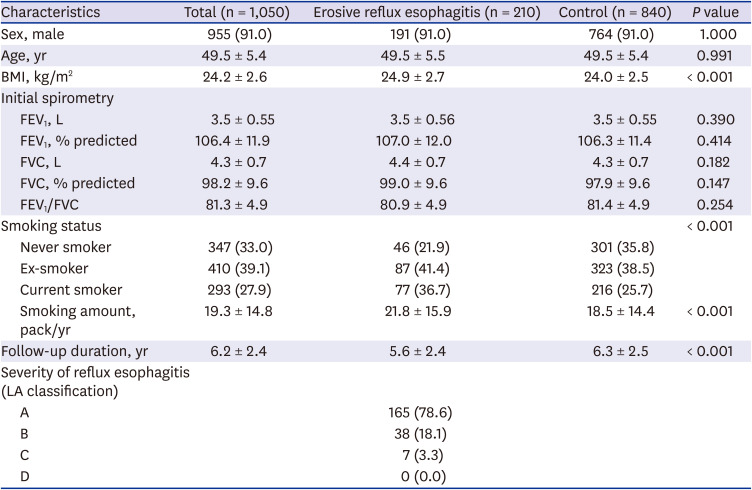





 PDF
PDF Citation
Citation Print
Print



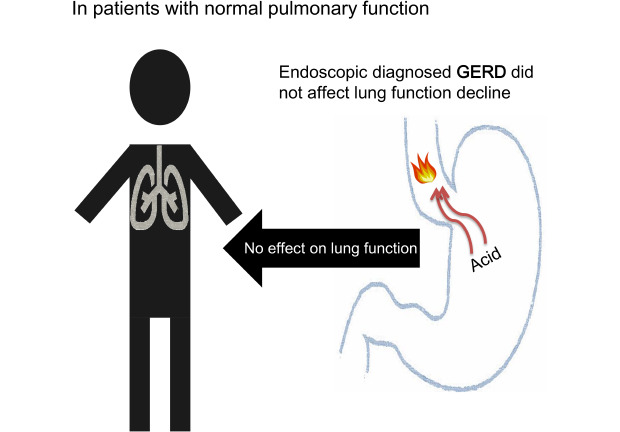
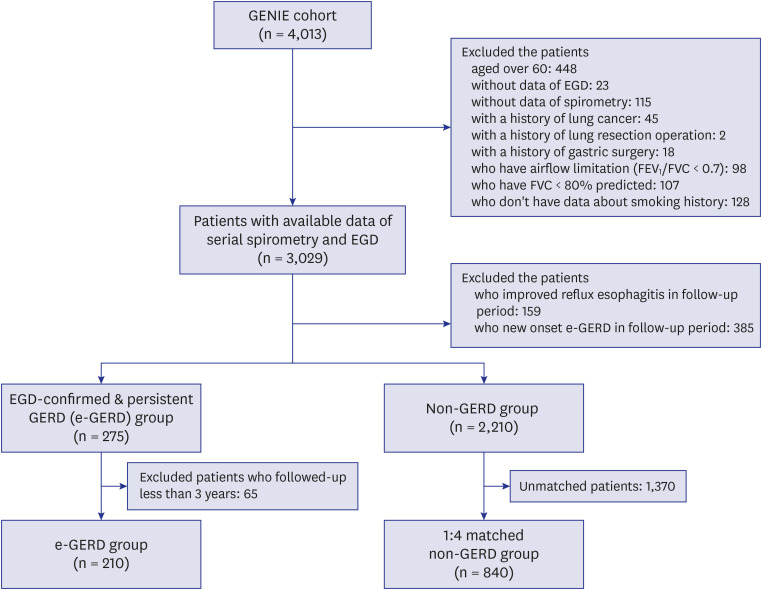
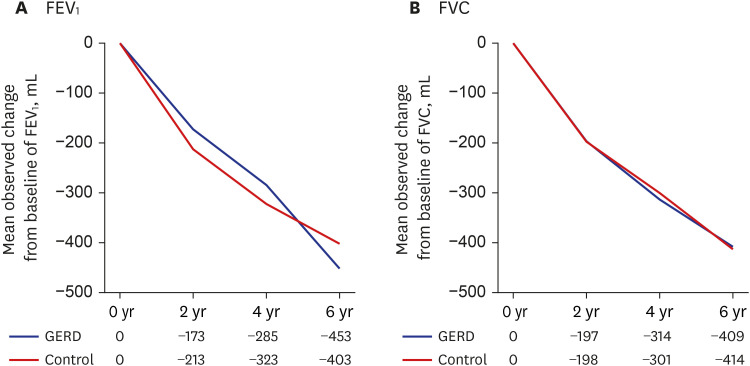

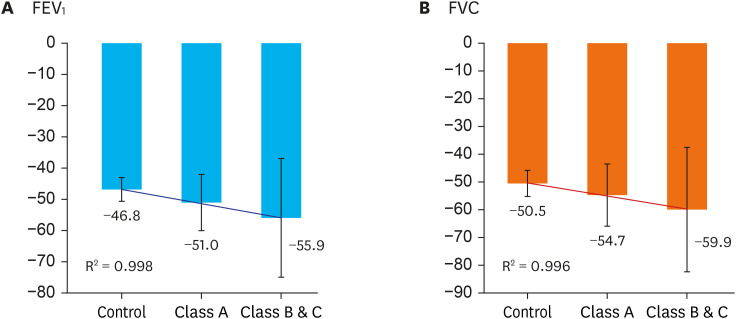
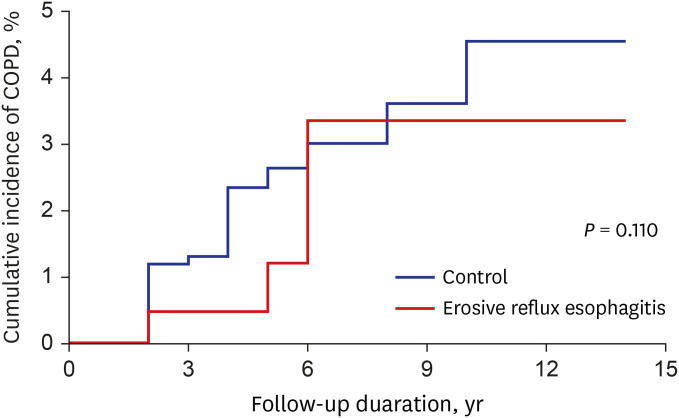
 XML Download
XML Download